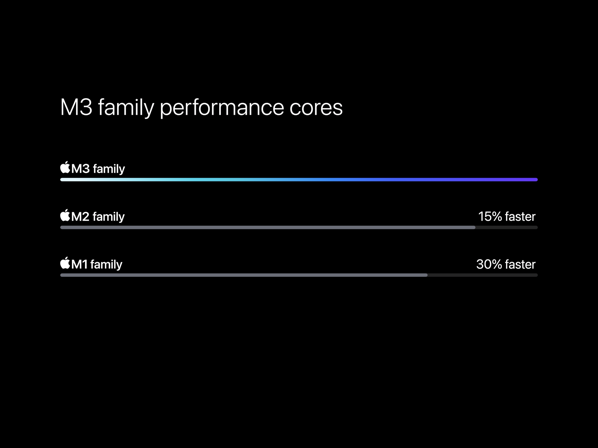
As it turns out, “scary fast” was referring to the fact that the event itself was contained to a tight 30 minutes.
I noticed a few things in the event:
- Macs are available with a dizzying array of chip options now. Not only do you get to choose between M3, M3 Pro, and M3 Max, but also within those families you can choose different amounts of CPU and GPU cores. This is in stark contrast to just a few years ago when you got one or two chip options for later Intel Macs. Is Apple selling Macs with all these options because it loves offering lots of choices to customers? I doubt it; this feels more like Apple being stuck doing this because there are no other computer companies to sell M3 chips to and Apple needs to sell every possible chip on the die, and the best way to do that is to sell the ones with fewer good cores for cheaper.
- Last month during the iPhone event people complained that Apple was often comparing the new iPhone’s performance to some other years-old iPhone instead of last year’s. For this event, they compared the M3 models to the M1, but in their charts they provided benchmarks comparing them to both their M1 and M2 counterparts, which is a nice touch for those trying to keep track of the year-over-year improvements. The practice of comparing to a 2 generation old chip feels deceptive but it’s a reasonable comparison to provide; someone with an M2 Mac probably isn’t considering upgrading yet, but an M1 Mac owner might be. Apple even threw in a few comparisons to their fastest Intel models of some Macs, and the comparisons were staggering (on one benchmark the new M3 chips were 11x faster than their last Intel Mac counterpart). That wasn’t to knock Intel; it was more to point out to Intel Mac owners the gains they can expect.
- The M3 generation sees better speeds and efficiency gains overall, but the gains are uneven. Memory bandwidth on the M3 Pros got slower than on the M2 Pros, for instance. Also, interestingly, you will get six efficiency cores on an M3 Pro, but on an M3 Max you only get four of them in favor of more performance cores. As a user of iStat Menus on my own M1 Max Mac, I can see that the efficiency cores are very hard working, usually pretty occupied with work, since they are usually the default chip for most work unless there’s something harder to be done. It’s interesting that you lose those extra efficiency cores on the Max, meaning that if you choose a Max, it better be because you intend to put it through its paces.
- I’m really delighted to see that Apple is launching a new chip family with three different variants on day one. There are still other chips to be announced in this generation. The Ultras, which are made by stitching two Max cores together, will come later, and maybe this will be the generation where we see the “quad” chip made of four Max cores.
- In a similar vein, I’m happy to see Apple releasing new pro computers with new chips as soon as they have them instead of waiting. If you bought an M2 MacBook Pro that might be a little disheartening that it didn’t even last a year without getting bested, but the computers are still plenty wonderful.
- Apple specifically called out that the 24“ iMac is a great upgrade for both older 24” iMacs and 27" iMacs alike, which is a bit discouraging as a 5K screen lover. I think that bigger screens are still coming eventually (I have been patiently waiting for a 6K version of the Studio Display), but it seems like Apple is subtly trying to tell iMac fans that if they want a Pro iMac they should be buying either a Mac Mini or Mac Studio with a Studio display. And I do appreciate that such machines are at least a bit more modular, allowing the computer and monitor to be upgraded separately, but it’s a bit of a shame to see an end to higher end iMac configurations, especially since Apple Silicon could make them great overall computers.
I’m really happy with where the Mac is at overall. I can recommend just about any Mac model now, and the only caveat I need to provide is to avoid the base models for their lack of memory and SSD (which I’m sad to say is a caveat I’ve needed to provide for awhile now).
Also, as someone who used to own the black Intel MacBook, I have to say the new space black color looks really sharp, and I am delighted that Apple designed it in such a way that it is less prone to fingerprints.
Leave a Reply